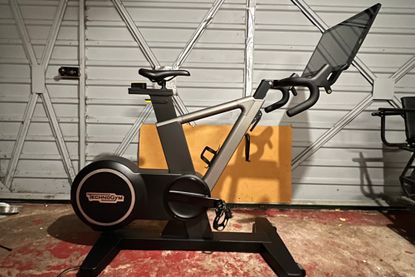Technogym Ride smart bike first look review - user friendly and 'realistic' but a heavyweight in both size and cost
The flagship model from the commercial gym equipment brand is designed to meet all your home workout needs, but has it missed its target?
- (opens in new tab)
- (opens in new tab)
- (opens in new tab)
- Sign up to our newsletter Newsletter

The TechnoGym Ride provides a solid platform and on-line virtual classes for riders whose daily fix of riding is important. It's not quite a bullseye for the brand when it comes to hitting the elite performance market, with peak power generation significantly lower than alternative smart bikes on the market. The simplicity of use is brilliant, but you might find yourself with hefty monthly subscription bills to get the most out of the bike. It's a well constructed option for home workouts but ideally could do with a couple of design tweaks - then it would be a great option for many, assuming it dropped the price by at least a quarter to bring it in line with other equally well performing smart bikes currently on the market.
-
+
Ease of rider position set up and two screen taps to get riding
-
+
Position adjustment simple
-
+
Solid platform and smooth ride feel
-
+
Plenty of metric data to monitor performance and progress
-
+
Lots of entertainment at your fingertips
-
-
Screen is too close to rider
-
-
Low peak power output for performance riders
-
-
Really expensive when compared to competition
-
-
Monthly subscriptions required for optimal use
-
-
Large and heavy, so requires a dedicated space
-
-
Cable port position sub-optimal
Why you can trust Cycling Weekly Our expert reviewers spend hours testing and comparing products and services so you can choose the best for you. Find out more about how we test.

There's been a flurry of dedicated home workout bikes in the last few years, giving riders more choice than ever when it comes to purchasing a specific machine to ride all over the world, without even opening your front door.
Technogym Ride is the latest bike to join this steadily growing market place. We've already spent time with a few of the best exercise bikes and smart indoor bikes (opens in new tab), with the likes of the Stages SB20 (opens in new tab), Wahoo's Kickr bike, the Wattbike Atom, and even the Peloton indoor training bike (opens in new tab) having been put through the Cycling Weekly Tech Team's paces, and there's still the Tacx Neo smart bike (opens in new tab)to go at too.
All the options are a big initial outlay, and when combined with a monthly subscription to get the most out of the virtual riding they have been designed for, it's a big investment and one that's vital to get right.
But with the world regaining a sense of normality after the past couple of years of suffering under the C word, are we even interested at staying home to workout anymore?
With all smart bikes jostling for position, TechnoGym Ride has to enter the breakaway with it's elbows out, and the biggest question on everyone's lips will be, can it take the win?
TechnoGym Ride: Construction
While the heart of a regular bike is it's frame, for an exercise bike it's the resistance mechanism, which on the TechnoGym is in the form of electromagnetism. It's the same system that's used across all brands of exercise bikes bikes and the best turbo turbo trainers (opens in new tab)at the higher price points.
This enables the bike to reach the 1500watts of claimed peak power, which is measured via dual strain gauges in the cranks, without a crazy sized or weighted flywheel to have to slow down via mechanical breaking. It also enables remote resistance simulation of climbs or descents as the adjustment is controlled electronically.
| Row 0 - Cell 0 | TechnoGym Ride | Stages BS20 | Wahoo Kickr Bike | Wattbike Atom Gen 2 | Tacx Neo Bike |
| Power accuracy | TBC dual sided | +/- 1.5%, dual sided | +/-1 | +/- 1% | less than 1% |
| Weight | 65kg/143lbs | 62.5kg/ 137.7lbs | 42kg/92.5lbs | 45kg/ 99lbs | 50kg/110lbs |
| Flywheel | 5.4kg/ 11.9lbs | 23kg/ 50lbs | 5.9kg/ 13lbs | 9.3kg/ 20.5lbs | TBC |
| Resistance Unit | Electromagnetic / Timing belt & Poly-V belt | Electromagnetic, Gates carbon belt drive | Electromagnetic 'enhanced motor' | Electromagnetic | Electromagnetic |
| Peak power | 1500w | 3000w | 2200w | 2500w | 2200w |
| Gradient simulation | -3 to +15% | 25% | -15% to +20% | 25% | 25% |
| RRP | £3999/ $TBC | £2800/ $3149 | £3299/ $3800 | £1999/ $2400 | £2299.99/ $3200 |
The frameset has adjustment points on the saddle fore/aft and height, handle bar height and crankset.
The saddle fore and aft has a 10cm range of adjustment. This provides a saddle nose to centre of bars distance of between between 430mm to 530mm, when set at a height for me, who stands at 170cm (5ft 6") and rides with a saddle height of 710mm.
The saddle height range is the biggest variable with a huge range between 640mm all the way to the heady heights of 910mm from the centre of the crank.
Looking at the seat post at full extension, it's hard to imagine the height of the rider requiring such leg span. A quick check of pro riders saddle heights reveals that Irish cyclist Conor Dunne rides at 950mm, for his 204cm (6ft 7") height, while 161cm (5ft 3") ex-professional rider Samuel Dumoulin (the Dumoulin that crashed in to the dog, not to be confused with 185cm tall Tom, of no relation) would certainly be more grateful for the other end of the saddle height spectrum.
At the opposite end of the top tube sits the integrated cockpit and screen. The handlebar has height adjustment, although of less a range at just 120mm of movement.
This does provide a pretty extreme dimension when the saddle is at it's tallest setting, especially as the screen only has a tilt option and no layback movement.
Other key adjustments that can be made are in the drivetrain area. Along with a choice of crank lengths, which are adjustable to 170, 172.5 or 175mm, there's also four riding disciplines options for either road, gravel, time trial and mountain bike gearing ratios.
Each discipline is capable of being set up to mirror most groupsets on the market, with up to three different sized double chain rings, and three cassette sizes to choose from depending on your bike style of your choice.
In terms of road bike setting this means a choice between 48/35, 50/34, 50/37 chain rings, which can be paired with 11-34t (11sp), 11-34t (12sp) or 12-25t (11sp).
Time trial gearings get beefed up to 50/39, 52/39 or 54/39 with either 11-30t (12sp), 11-34t (12sp).
Gravel, however, comes with a single chainring, a 44t, and a choice of 10-28t /-33t /-38t (12sp) cassettes, with a similar option for the mountain bike setting.
TechnoGym Ride: Data metrics
In terms of measuring performance, it's a case of what numbers doesn't the TechnoGym Ride monitor?
As mentioned above, power output is constantly monitored, with a left/ right pedal breakdown of cadence, symmetry and circularity capabilities.
Heart rate, ride duration, speed, rpm and watt per kg are also displayed, with both current and average numbers monitored for each ride. It's compatible with Bluetooth and ANT+, so also capable of capturing and mapping rider heart rate via your preferred HR monitor.
Depending on the ride you've opted for you can also track this next to target goals, or percentages of FTP, max numbers or zones.
Post ride there is the ability to paw through the data either in it's raw state, or automatically import it to your favourite number logging and analysis platform, such as Training Peaks.
TechnoGym Ride: Connectivity
It's here you find the TechnoGym Ride's unique raison d'etre: it's entertainment connectivity and integration.
While build-in touch-screens are nothing new, Peloton are an obvious comparison for example, not having it wedded to a brand of software is.
The 22" 'home screen' gives you multiple workout choices:
There's just hopping on a pre-set workout, spin bike class style, with a choice of trainers to talk you through your places.
A customised training session, which you can download from TechnoGym's own platform, Training Peaks or another brand of training software and choose from it's own music library to entertain your ears.
Head to the Outdoors channel, and choose one of several routes, from well know climbs to flatter less familiar locations.
Or use the quick link to head over to the virtual world of Rouvy , for a solo or group ride.
There is also a quick tap access to all your apps, with most popular options available, although it's worth noting, if you are planning on linking the TechnoGym bike with Zwift, you'll need an HMTI cable to your laptop to access the software, with the screen on the bike acting as your ride view screen. Although you could just as easily (or arguably even easier as no cable required) log on to your GCN/ Eurosport/ Netflix account for some alternative viewing entertainment.
Finally, a quick swipe right and you find the Strength portal, with access to trainer lead sessions on stretching, weights, core and general off bike mat based workouts.
TechnoGym Ride: Subscriptions
However, this level of connectivity is only as strong as your subscription services. The bike in it's stand alone state allows a certain amount of use, with six sessions freely accessed, as well as your own customisable training, and, if you are already signed up, your Zwift or alternative on-line riding platform.
Teaming with a TechnoGym subscription of £29 a month, and that gives up to five people access to all the sessions, including Rouvy.
Access to any other app will also require a separate subscription service.
TechnoGym Ride: The ride
My time with the TechnoGym Ride has been brief, which was made briefer still by a week of un-rideably hot weather, hence the first look review at this stage.
The jump out feature is it's plug and play design. After downloading the app on to my phone, pairing the bike with my home wifi and setting up my profile I was ready to rock. Simple as.
No waiting for something to charge or download. You literally have to switch on and tap the screen twice to get riding up a famous Col.
Again, due to time limitations with the bike, I didn't massively customise the Ride beyond dialling in my position and inputting my personal metrics. I even stuck with the SPD pedals the bike came with, although that would be the first swap out if I was purchasing the bike.
This swiftness is a game changer for me. Doing away with all the stress of lagging connections and two screens meant that for the first time I got the point of VR riding over my usual just staring at uncomplicated numbers.
But despite the ease of a tippy-tappy a screen, it became clear that it was either very close or too big. According the Health and Safety Executive (HSE) the recommend distance from eyes to monitor is about an arms length, while common consensus, and as shown here in the Sony support guide (opens in new tab), for 22" TV screens is 80cm.
Measuring just under 50cm from my nose to the screen when on the hoods, it was visually uncomfortable. In the drops, or out the saddle it was verging on the painful to look at the screen. As someone who is long sighted, an hour of this was more than enough for my eyes, and even my other half who is very short sited (in the +9 lens range) felt uncomfortably close.
An area where TechnoGym has absolute got it right is the pedalling. The smoothness of the system is impressive, and it's clear the brand has put its knowledge of commercial gym equipment in to use.
The gradient changes felt swift, and reasonably realistic, although maxing out at +15% will make some Cols or hilly rides less realistic if they have steeper inclines.
Everything feels super solid, durable and is easy to adjust. The noise level is a subtle shushing, on a par with what we found with the Stages SB20 exercise bike, over the rolling hum that most bikes and turbo trainers come with.
This makes it easy to locate in the home without overwhelming other householders with an audible assault when in use. That's assuming that you can get it inside.
With the bike weighing a (claimed) 63kg or143lbs and living in a funny level changing house with a front door up steps and round a corner made this impossible for me to lift and wheel inside, so the bike was banished to the garage.
While this has it's perks for being out of the house, it did make it tricky to carve ride time as a parent to a young child who, while would normally be content to potter around the house while I trained in a different room; me being in the garage didn't sit well for either of us.
It won' t be an issue for all users, but is worth considering if you don't have the space in the house for such a large and heavy unit: at 1545mm/61inchs long, 642mm/ 25inchs wide and 1420mm/ 56inchs tall, there's no just popping this beast behind the sofa when not in use.
As for its accuracy, a longer, in-depth look would have allowed me to have simultaneously ridden the Technogym Ride with a pair of power pedals. However, gauging on the riding and courses completed, the metrics look and feel about right.
TechnoGym Ride: Value
Setting the RRP on the TechnoGym Ride at £3,999 is a bold move from the brand, especially at a time where the cost of living is rising and many of the home exercise platforms (read Peloton, Wahoo, Zwift and Whoop) are making hard cost cutting decisions.
This price for the bike is almost double that of the likes of a Wattbike Atom, Stages SB20, or even the Peloton Bike +.
There is no denying the quality of the bike's construction, but it's only really as strong as it's interaction, and to get the most out of it, you really do need to cough up for the £29 a month subscription, along side you membership to any other monthly subs, such as Zwift, Netflix or Amazon Prime.
There is the fact that you could have multiple users on one Technogym subscription, but that'll only gain access to it's own sessions and Rouvy.
But even if you had five users, you're still looking at roughly £72 a month each for for first year ownership (assuming the first months subscription is free).
Admittedly that does include the bike purchase, but realistically are you always going to be in a household of five keen cyclists long enough to eventually write off the cost of the bike?
There is the choice of splitting the bike cost over 36 months interest free, so £399 deposit and then £99.75 a month there after. But three years of £50 a month, and the initial £80 deposit each, is still a bigger long term commitment than most five person relationships would be sensible to enter.
Even if you do find yourself living in a cycling Nirvana, you're going to have to run a pretty tight schedule to make sure everyone actually gets ride time, with just an hour each a day for six days a week equating to a full time job for the bike at 39hours.
Technogym Ride: Conclusion
So where does this leave the newest kid on the smart bike block?
I can't help feeling that TechnoGym has somewhat missed the home fitness boat on this, with 'cancel Peloton subscription (opens in new tab)' hitting an all time high at the end of last year.
With the requirement to work out at home no longer a pandemic essential, if it were in a commercial gym, I could see myself migrating over to the bike for a couple of weekly rides. Although it's generally accepted gym etiquette that hogging the same piece of CV for an hour or more is unacceptable.
When it comes to number crunching, there's not a metric missing that it doesn't reveal and record, but the 1500w max power will be an issue for performance riders.
It's nearly 1000w astray from the other smart bikes peak power when comparing directly to the Stages SB20, which maxes out at 3000w, Wahoo Kickr bike, 2200w, Wattbike Atom Gen 2, 2500w, and Tacx Neo bike. 2200w.
In this company the TechnoGym is starting to look like a scaled version of the elite performance it was trying to tap in to, and landing just wide of target.
I admit the instant access to getting riding is dreamy, the zero faff time requirement really rings my bell. Who wouldn't want to have this level of software performance?
It feels like the indoor smart bike equivalent of Apple Mac or Garmin Edge when it comes to intuitive and speedy connectivity, but performance wise, it's more amateurish, with a closer affinity to Peloton or a Yoga with Adriane class.
All in all, it's a solid platform, and definitely a gym pleaser, but ultimately just a better designed spin bike with a big monitor, that's a bit too close for comfort.
Even as a big fan of it's user friendliness, I couldn't justify the outlay and ongoing monthly bill over other cheaper options on the market.

Thank you for reading 10 articles this month* Join now for unlimited access
Enjoy your first month for just £1 / $1 / €1
*Read 5 free articles per month without a subscription

Join now for unlimited access
Try first month for just £1 / $1 / €1
Hannah is Cycling Weekly’s longest-serving tech writer, having started with the magazine back in 2011. She has covered all things technical for both print and digital over multiple seasons representing CW at spring Classics, and Grand Tours and all races in between.
Hannah was a successful road and track racer herself, competing in UCI races all over Europe as well as in China, Pakistan and New Zealand.
For fun, she's ridden LEJOG unaided, a lap of Majorca in a day, won a 24-hour mountain bike race and tackled famous mountain passes in the French Alps, Pyrenees, Dolomites and Himalayas.
She lives just outside the Peak District National Park near Manchester UK with her partner, daughter and a small but beautifully formed bike collection.
-
 Closing the gap: David Gaudu emerges from Paris-Nice more confident than ever before
Closing the gap: David Gaudu emerges from Paris-Nice more confident than ever beforeThe Groupama-FDJ rider finished second overall at the Race to the Sun, but gained more than just the result
By Adam Becket • Published
-
 Goodbye lime: We need to talk about the Tour de France green jersey
Goodbye lime: We need to talk about the Tour de France green jerseyThere's change afoot at ASO's French races, with the combativity colour also undergoing a revamp
By Adam Becket • Published
-
 Andrei Kivilev remembered 20 years on from his death at Paris-Nice
Andrei Kivilev remembered 20 years on from his death at Paris-NiceKazakh rider’s death during 2003 edition led to helmets being made obligatory in racing
By Peter Cossins • Published


